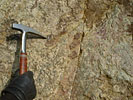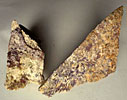|
|
Dunbrack
Pb, Cu, Zn, Ag Mine,
Halifax County
|
UTM (NAD27)
Zone 20
|
Northing
4962571 |
| Easting
484916 |
|
Details:
|
The Dunbrack Pb, Cu, Zn, Ag Mine (really only
a development prospect by modern mining standards) consists of two
shafts found a few kilometers north of the village of Musquodoboit
Harbour, Halifax County. |
|
References:
|
NSMOD
#D14-009 |
|
Further
Info:
|
extensive information & references available
in the Mineral Database |
|
Other
Minerals:
|
galena, tridymite,
tourmaline, azurite,
pyrrhotite, cerussite,
ilmenite, djurleite,
digenite, chalcopyrite,
sphalerite, pyrite,
bornite, chalcocite
malachite, meneghinite,
pyromorphite |
|
Kinsac
Pluton/Limestone Avenue, Fletcher's Lake, Halifax County
|
UTM (NAD27)
Zone 20
|
Northing
4965100 |
| Easting
450950 |
|
Details:
|
Subdivision development roadside outcrop |
|
References:
|
NSMOD
# D13-044 |
|
Further
Info:
|
NSDNR Open File Map 1998-006 FALL RIVER 1:10,000 |
|
Other
Minerals:
|
Barite |
  |
|
Meat Cove
Zn Deposit, Inverness County
|
UTM (NAD27)
Zone 20
|
Northing
5208730 / 5208360 / 5208160 |
| Easting
682840 / 683150 / 683150 |
|
Details:
|
The Mine Road leads south from the Meat Cove-Lowland
Cove Road, approximately 3.2 km west of the village of Meat
Cove (200 m west of the juncture of the road with French Brook).
The Northwest Zone is exposed along a brook valley, a short
distance west of the Mine Road, approximately 600 m south of
the juncture of the Mine Road with the Meat Cove-Lowland Cove
Road. Coordinates 2: Adit Zone The adit is located along the
Mine Road, approximately 500 m southeast of the Northwest Zone.
It was driven on a steep east dipping slope, along the south
side of a tributary of French Brook. The discovery outcrop is
located along this tributary, approximately 70 m northeast of
the adit portal. Coordinates 3: South Trench Zone Two large
trenches are found on top of the hill, approximately 200-300
m south of the Adit Portal.
|
|
References:
|
NSMOD
#N02-002 |
|
Further
Info:
|
The Meat Cove Deposit is primarily a Zn deposit in which
sphalerite is the dominant sulphide mineral. The sphalerite
occurs as coarse grained massive crystalline aggregates, as
disseminations, as bands and as veins. Chatterjee (1979) reported
that sphalerite commonly replaces brucite, antigorite and pyrite.
He also noted that the most significant Zn-mineralization occurs
as a replacement of forsterite bearing units within the magnesian
alteration zone. Other minerals reported to occur within the
deposit include pyrite, pyrrhotite, chalcopyrite, galena, graphite,
fluorite, arsenopyrite, stannite, germanite and renierite. Pyrite,
which is the second most common sulphide mineral, occurs as
independent crystals and aggregate masses.
|
|
Other
Minerals:
|
sphalerite, arsenopyrite,
marcasite, stannite,
braunite, pyrite,
pyrrhotite, germanite,
renierite, galena,
chalcopyrite, graphite |
|
Reeves
Tin Pit, Lunenburg County
|
UTM (NAD27)
Zone 20
|
Northing
4953870 |
| Easting
379700 |
|
Details:
|
The Reeves Tin Pit is located 5.1 km west on the Dalhousie
Road (Forties Road) from the village of New Ross, Lunenburg
County. The prospect is found within the community of Forties
and 0.5 km south of road on the Reeves farm. Reeves is a common
name in the New Ross area. The prospect may be reached by going
80 metres south along a woods road that starts at a small man-made
pond behind the barn on the Reeve's farm. At that point turn
west from the woods road onto a foot path and walk southwest
for 120 m to a cleared area. The prospect is located in this
cleared area and in 1982 consisted of a water-filled pit, outcrops
and overburden dumps (O'Reilly et al., 1982). Since 1982 the
pit has been filled in by the land owner but dump material can
be found laying about.
|
|
References:
|
NSMOD #A10-004 |
|
Further
Info:
|
Mineralization: Flecks of fluorite and blue-turquoise
fluorapatite are common in the pegmatite and associated leucogranite
that accompanies the pegmatite. The mineral assemblage that
is reported to occur in the central zone of the pegmatite is
impressive and includes: cassiterite, amblygonite, lepidolite,
fluorite, topaz, tourmaline, beryl, wolframite, scheelite, columbite,
durangite, metatorbenite, tapiolite and monazite. A Department
of Mines and Energy field check reported in 1982 indicates that
most of these minerals are not obvious and only fluorite, lepidolite
and fluorapatite were noted (O'Reilly, et al., 1982).
Faribault (1908) reported that a pit was dug in 1903, uncovering
cassiterite- and fluorite-bearing quartz boulders. Consequently,
digging continued and a shaft was sunk into bedrock with work
continuing for the next few years. A pit was sunk (7.5 m deep,
3.6 m long and 3 m wide) on a pegmatitic segregation within
light grey leucogranite. The site has been visited by numerous
persons since Faribault's time but the dyke was apparently not
visible due to the water level in the pit and the fact that
much of the outcrop had since been covered over by dump material.
|
|
Other
Minerals:
|
amblygonite,
microlite, monazite,
morinite, scheelite,
tapiolite, topaz,
tourmaline, triphylite,
tungstite, wolframite,
apatite, fluorapatite,
beryl, cassiterite,
columbite, durangite,
lepidolite, metatorbernite |
|

